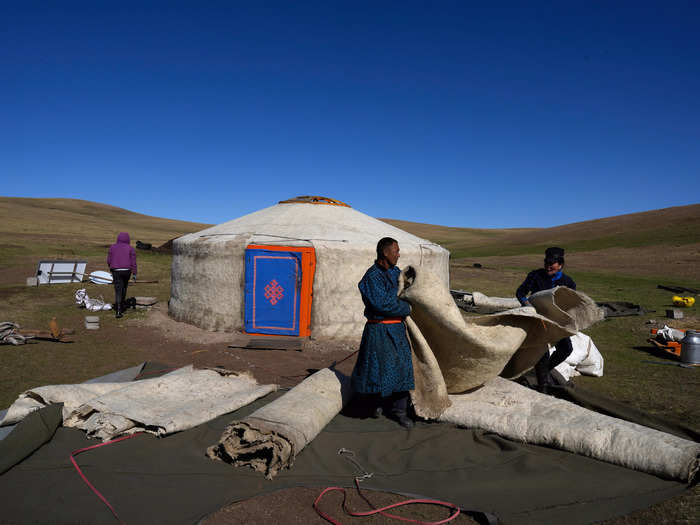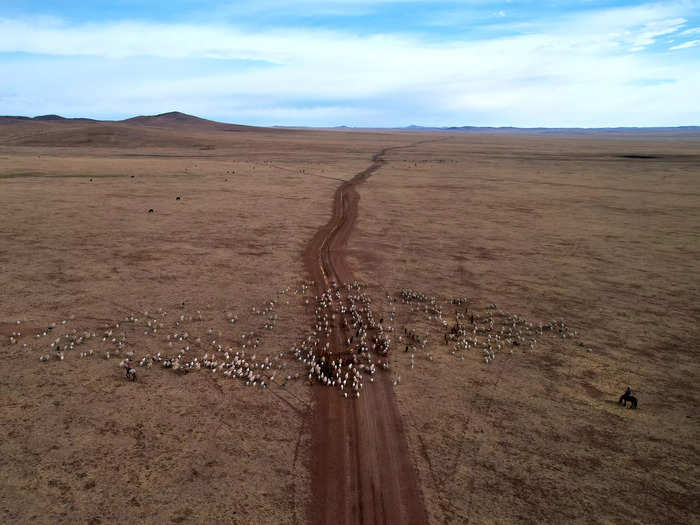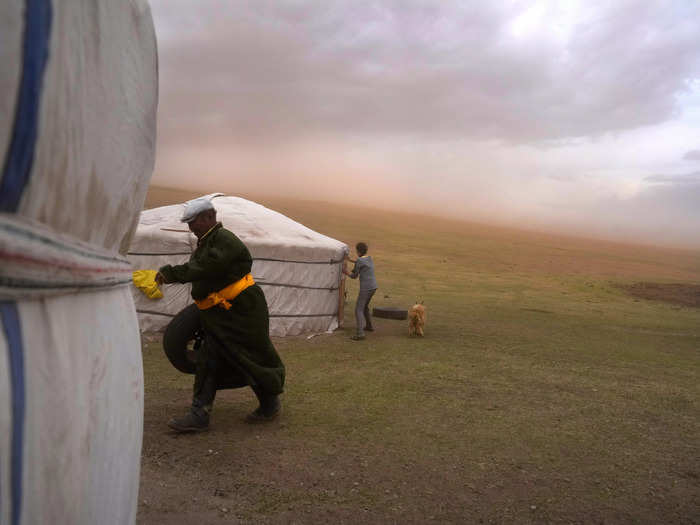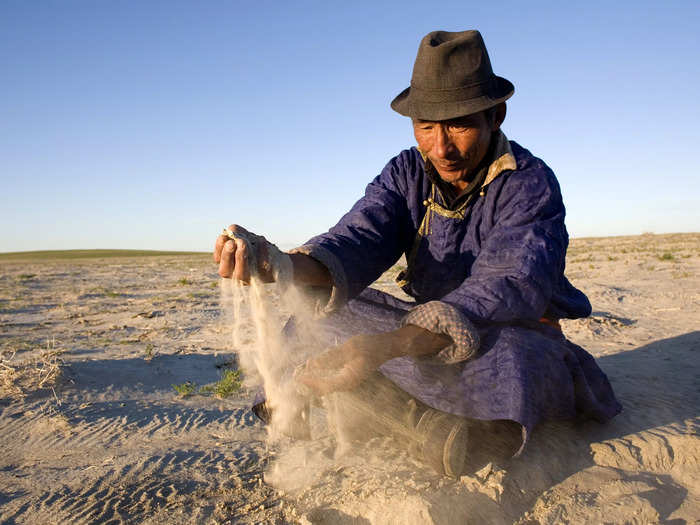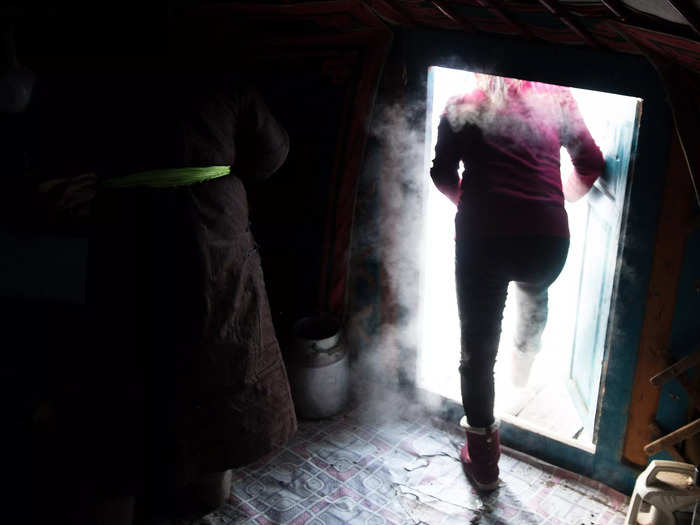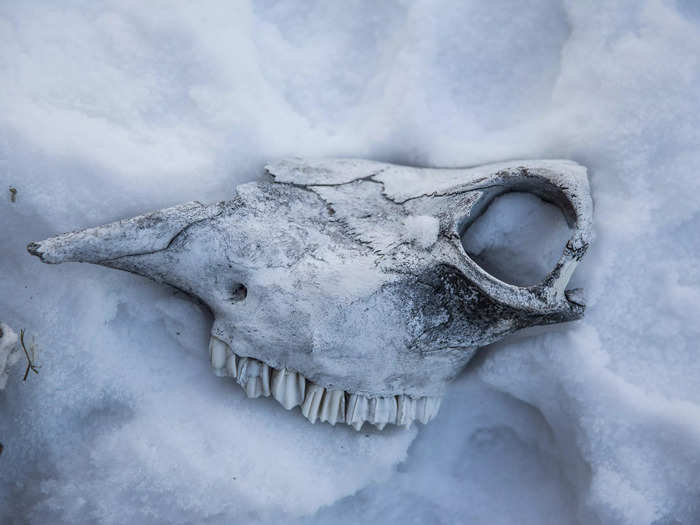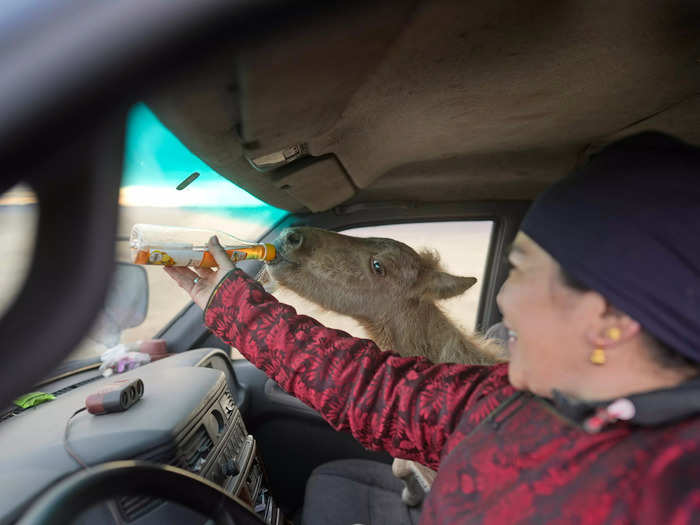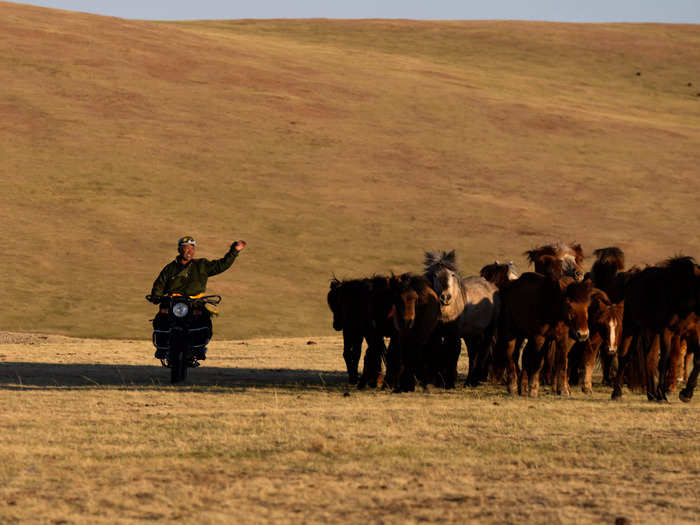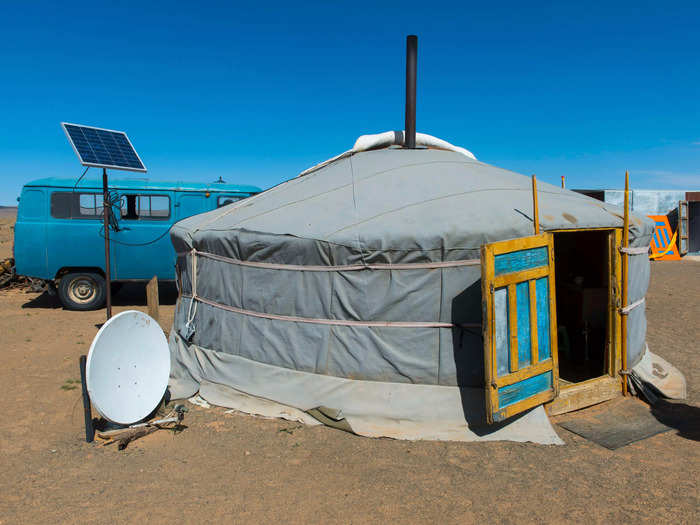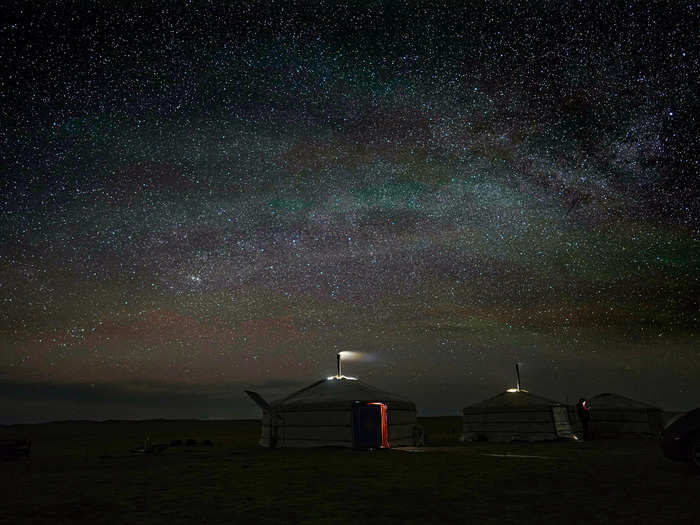A man holds his cap as a sudden dust storm swirls around outside.Manish Swarup via AP Photos
- Herders in Mongolia are facing tough decisions as the climate crisis threatens their way of life.
- Herders make up about a third of the population of Mongolia.
Herders in Mongolia have dealt with unpredictable weather, but as the climate becomes more erratic, they are forced to travel further and further to manage it.
The nomadic herders make up a third of the three million people in Mongolia. But their numbers are at risk of falling as the weather worsens and the land becomes harder to graze on for their animals.
The temperature in Mongolia has increased by 2.2 degrees Celsius since 1940, and 90% of the grasslands in Mongolia have been impacted by desertification due to poor management and climate change.
Herders are also losing their livestock at alarming rates; as of March 2023, they have reported losing over 500,000 animals nationwide, according to the United Nations Development Program website. These losses are devastating for families who receive 80% of their income from selling animals and animal products.
Herders in Mongolia are nomadic, moving from place to place in search of the best lands for their animals.
A family deconstructs their "ger," a portable tent insulated with sheepskin that they take with them from location to location. Manish Swarup via AP Photos
While traveling, they live in a tent called a "ger," which is insulated with sheep skin and has a hole in the ceiling to dispel smoke from their furnace.
The ger can be easily set up, deconstructed, and follow the families everywhere they travel.
As there becomes less arable land due to climate change, herders have to travel further for food for their herd.
A herder overlooks his herd as they travel down a road. Manish Swarup via AP Photos
In 2020, Agvaantagtokh, a herder in Mongolia, and his family traveled 750 miles to find better land after losing most of their animals to a particularly bad winter.
More desertification means more dust storms, which also increases the risk of losing animals.
Two herders check their ger during a sudden dust storm in the Munkh-Khaan region of the Sukhbaatar district in southeast Mongolia. Manish Swarup via AP Photos
Rivers and streams are drying up, prompting herders to make a six-mile trip to the nearest well.
A Mongolian nomadic herder, runs sand from a dry lake bed through his hands. Palani Mohan via Getty Images.
Usually, streams are shared by all surrounding communities and their animals. Typically, there are 10 to 15 communities in a given area and a collective of 4,000 to 5,000 animals.
The United Nations Development Program has invested in the protection and fencing of springs.
The UNDP's project allows for less congestion of streams by animals and allows dried-up streams to make recoveries.
In one instance, a spring that was blocked by a large herd of animals was restored after being fenced and even formed two small lakes along the length of it, according to the UNDP.
Mongolia is also subject to severe winter storms known as dzuds.
A young woman walks out into the biting cold from her family's ger in a dzud affected area. Taylor Weidman via Getty Images
Temperatures can drop below -40 degrees Fahrenheit, and the winds tear across the large fields without trees or tall vegetation to block their path.
Dzuds are the deterioration of winter weather conditions that result in the mass death of livestock.
Dzuds arrive from Mongolia's unique landscape. The landlocked, semiarid country is subject to swings in temperature, and the heavy snow and harsh cold block pastures or kill animals entirely.
The dzud from 2009 to 2010 killed 22% of Mongolia's livestock.
Dzuds are happening more often, making it harder for herders to keep their livestock alive.
A skull sits on the snow covered ground in a dzud affected area in Darkhad Valley, Khovsgol Province. Taylor Weidman via Getty Images
Dzuds used to occur once or twice a decade, but since 2019, they've occurred annually.
Typically, communities would gather their horses together during the winter to protect them from the storms. The gathering was not only strategically viable but was a coming-of-age tradition for the young men of the community.
As winters worsen and droughts become more intense, there isn't enough grass to sustainably feed all the horses. Al Jazeera reported the winter herd of horses hasn't occurred since 2018.
Younger generations still want to grow up to do what their parents do, but parents are increasingly trying to ensure they have other options.
"I am glad that he wants to carry on our herding tradition," Narangerel, a herder in Mongolia, said of his son to the UNDP. "However, I want to ensure that he receives a secondary education before he chooses to become a herder and wrestler."
Herders are still finding ways to adapt to the changing environment.
The sister of a herder feeds a young foal while driving to a new pasture. Manish Swarup via AP Photos
Motorbikes allow herders to track lost horses and sheep faster in dust storms.
A herder rides along his horses in Mongolia. Manish Swarup via AP Photos
Horses are never kept fenced in these communities, so every now and then, they can wander off. The motorcycles allow herders to find their horses more easily and tell others where they are grazing.
Herders are also using solar panels and satellite dishes to improve communication networks.
A herder ger camp with satellite dish and solar panel. Wolfgang Kaehler via Getty Images
Mongolia relies on China and Russia for most of its imports. In 2021, 36% of their imports were from China, and 29% were from Russia.
Solar panels allow them to be energetically independent and provide energy to charge their phones, which they use to exchange information with community members, the Associated Press reported.
The energy provided by the solar panels also allows them to keep freezers running and preserve their meat for longer.
The United Nations is also trying to find economic alternatives for herders.
Stars light up the night sky over a ger in the Mongolian plains. Manish Swarup via AP Photos
The UNDP has set up the "ger and nature" initiative, which aims to "promote community-based eco and cultural tourism" by turning to the herders as tour guides.

